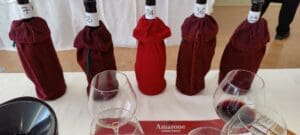Yes, you saw the title correctly. If you are still in disbelief, read the following words. Durian. Wine. If you are a fan of both, go ahead with the curious “ooh” and delightful “ah”. But consuming one within short interval after the other is known to have a lethal effect, so is the lethality going to be greater than the sum of its parts?
Production of tropical fruit wines are already known among Indochina countries. Most, if not all, are made in rural way involving minimal technology and scientific studies. At times, these productions are illicit, making them moonshine of the south-east Asia. While some travellers have found these wines appealing, my experience with mangosteen wine, for one, was far from delightful. A deep copper-like tone with dense horrid medicinal odour that matched Chinese medicinal rub more than what seems fit for oral ingestion. Then again, I cannot be certain of the authenticity or provenance of that bottled horror.
Unlike most other fermented tropical produce, durian wine was unheard of, making the research in National University of Singapore a world’s first. Although the thorny king of fruits is associated to the Malesia region (Malaysia, Thailand, Indonesia and Philippines), durian trees can be found in Cambodia, Laos, Vietnam, India, Florida, Hawaii, Papua New Guinea, Madagascar, southern China (Hainan Island) and northern Australia.
In other words, durian may grow where coffee will.
Going scientific
The idea of smelling durian aroma from the glass was less than welcoming. I wasn’t surprised with the torrent of quick negative replies from my non durian-loving friends. The fruit aroma easily goes over the scale, comes around the odour spectrum and become pungent. In reality what hits the nose is a combination of sulphur, esters and ketones. Posing this foul question to lead researcher Dr Christine Lee, and her assurance was to leave sulphur to the yeast.
Yeast, really? Miss Fransisca Taniasuri, who recently graduated with an Honours degree, highlighted that not all sulphur compounds are toxic. In specific cases, sulphur is an essential building block. The choice of yeast for research was the same for grape juice fermentation, Saccharomyces. The con of natural occurring sulphur is the risk associated with alcohol pairing. Sulphur inhibits enzyme that breaks down a toxin known as acetaldehyde, resulting in an excessive amount retained in the body. While acetaldehyde may not be an instant killer, it has been scientifically proven to increase cancer risk.
One more lesson learnt from visiting my Alma Mater, and obviously I wasn’t a science major.
A ripen durian fruit can reach a sugar level as high as 38°Bx (Brix), capable of making a fortified wine (assuming the yeast survives). Cabernet Sauvignon in Napa on average are harvested at 28°Bx. The greatest challenge with making wine from durian is the absence of readily available juice. This impedes yeast functions and adding water becomes a necessity. Increasing yeast homogeneity and reducing sugar density, the result was a wine that had less than 10 per cent alcohol by volume.
I was presented three smelling samples with various fermentation processes. All three reminded me of prepared durian dessert instead of the raw fruit. Two samples were malo-lactic fermented, with the concurrent fermentation sample giving a more pronounced buttery flavour. Christine wasn’t a fan of durian, but whatever odour remained after the fermentation was manageable even for her olfactory system.
What future does durian wine holds?
Imagine choosing wines labelled as Golden Phoenix, Red Prawn, Mao Shan Wang or in this case D-666. How cool is that? But this is not going to take place in the near future. First step is commercialisation and sustainable production. While the market is likely to respond slowly with a sceptical outlook, the ability to ferment wines from durian gives farmers a channel to turn loss into revenue. Transforming excess perishable stockpile into a product with longer shelf life will reduce fruit wastage. Bringing the odour intensity down will also makes it more appealing to people who had been hesitant on trying the fruit.
But there are still questions unanswered. Will different durian give different aromas? Does place of origin affect the wine’s profile? Will climatic and harvest conditions going to play a major role in the vintage variability? Only more experiments can tell.
If the wine is musky will it be termed as “foxy”, or more aptly, “prickly”?
Cover photo courtesy of National University of Singapore



